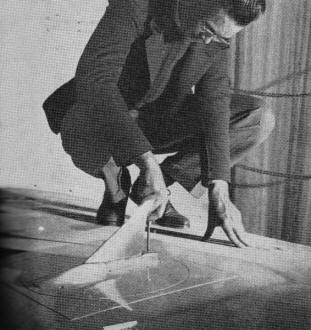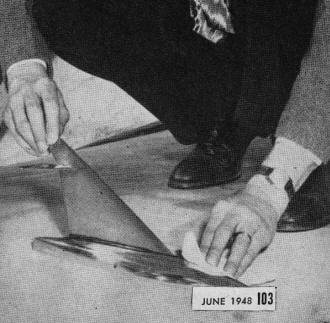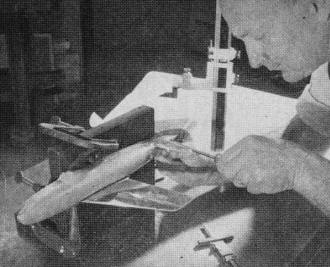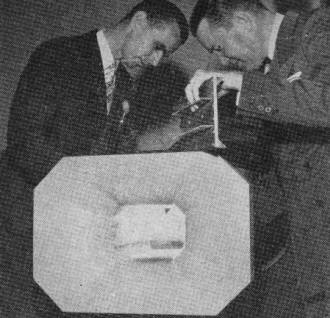|
Chuck Yeager broke the sound
barrier in his Bell
X−1 (aka Glamorous Glennis) airplane on October 14, 1947, over the Mojave Desert.
Control reversal in the transonic realm (transitioning from subsonic to supersonic
speeds) is a phenomenon caused, per most authoritative sources, from the pressure
wavefront around the aircraft transitioning from entirely in front of the airplane
to some point aft of any leading portion of the airframe. That includes the fuselage
nose, and wings and empennage leading edges. Airflow can transition from laminar
to turbulent at various distances, thereby altering the aerodynamic forces on the
fixed and moving portions of the surfaces. Control reversal can also occur due to
control surface deflection causing a twist in the fixed surface which opposes the
input intention. Britain's Spitfire exhibited such behavior in high speed dives,
and even the human-powered
Gossamer Condor
reportedly had control reversal due to a flimsy airframe structure
to the extent that the solution was to reverse the direction of aileron deflection
in order to obtain a proper response. Supersonic airframes are rigid enough to mitigate
the flexure problem.
Planes Race Past Sound; Bump in Floor Shows How

Model wing is installed, below, on turntable.
It has 6.8-inch span and is swept back at 60° angle. During tests, air speed
over wing is measured by pressure openings on bump and in vertical plate, 10 inches
high, that can be seen in photo at the top of the opposite page.
By squeezing air in a wind tunnel, engineers help solve the problems of flight
through the transonic region.
By Andrew R. Boone
For years pilots and engineers have worried about what would happen to an airplane
that entered the terrifying region bounded by the speed of sound. Under that speed,
an airplane was safe; above that speed, an airplane would be safe. But at that transonic
speed the cockpit controls might "reverse," and a plane do just the opposite of
what it was supposed to do. Transonic forces might even shake a plane apart.
Now they know that little need happen at the speed of sound that doesn't happen
normally in flight at other speeds. In fact, the government research agency, the
National Advisory Committee for Aeronautics, refers freely to "the transonic research
airplanes now flying."
The scientists have discovered what to do to an airplane to make it fly successfully
into and through the mysterious transonic region. They found out by building a bump
in a wind tunnel to produce an air speed equal to that of sound, and testing the
behavior of model planes and parts in this blast.
Without the bump, air blown through the tunnel flows smoothly at speeds below
that of sound; but, just at that speed, it "chokes" between the walls and the test
model. With the bump, air moving slightly slower than sound is squeezed up to transonic
velocity for a fraction of a second just where the tunnel narrows - and where the
test model is placed. Beyond the bump, the air slows up again before it has had
time to choke the tunnel.

Model is polished before a high-speed test run
to remove surface irregularities whose air drag would be magnified many times when
readings of instruments in the wind tunnel are translated into stresses on a full-sized
aircraft flown at the corresponding speed.

Model is assembled for test at transonic speed
in wind tunnel with bump. Wing shown here, made of machined brass, has 5-inch span
and 28-degree sweepback. Maple fuselage, shaped like that of P-80 Shooting Star
jet fighter, is reinforced by aluminum strip along its base.
One miniature model, made wholly of metal, began disintegrating at the speed
of sound - 763 m.p.h. at sea level. But this was a planned disaster. By shattering
its wing, Lockheed Aircraft's scientists, working at California Tech's Cooperative
Wind Tunnel in Pasadena, proved that this particular design could never endure supersonic
flight.
Other designs can and will. This too has now been proved. The logical design
for the airplane assaulting the transonic barrier is as smooth as a torpedo.
Air 'Boils' at Speed of Sound
"In the past" we have had trouble in the speed-of-sound region because air gets
flustered at that velocity," says Hall Hibbard, Lockheed's chief engineer. "It acts
like boiling water. But air is stable both below and above that speed."
"We have had trouble because air flows at different velocities over different
parts of an airplane. A plane may be flying at 600 m.p.h., but the air must flow
763 m.p.h. or faster to get over some projection - like the cockpit cover. It's
the parts of a plane, not the entire structure, that run into trouble."

Miniature wind tunnel, patterned accurately
to one-hundredth of an inch on the big one at Caltech, served as a working model
in which these Lockheed engineers perfected bump that produces transonic air speeds.
Experimental bump, of brass, is visible inside its mouth.
So the trick is to design a plane that will disturb the temperamental air as
little as possible. It will take extra-clean fuselages to pierce the transonic wall.
It is also reasonable to expect, on the basis of these experiments, that these airplanes
will need swept-back wings. Here's why this is so:
On the conventional Lockheed Shooting Star jet fighter. air drag suddenly goes
up around the wing at 625 m.p.h. Things get worse so fast that this resistance is
almost eight times as great at the speed of sound as it is at 625 m.p.h. But sweep
back the wing 50° and the air doesn't start to act up until 742 m.p.h., and
the resistance at sound's 763 m.p.h. is only twice as great. This means that a conventional
Shooting Star would require 55,000 hp. to smash through transonic resistance; one
with a wing swept back 50°, only 22,400 hp.
Wings will be thinner too, the wind-tunnel tests show, but they must be rugged.
Otherwise, they may twist under pressure of the aileron and thus apparently reverse
the effect of the controls. When this danger is avoided by proper design, the transonic
barrier is reduced to a momentary loss of control due to air turbulence. And designers
hope to get around even that by altering the tail.
"Tails present the same problems as wings," explains Paul W. Theriualt, Lockheed's
wind-tunnel chief. "They are actually small wings. There will be a tendency to place
the tails higher and farther from the wings, to get them away from the wake and
turbulent air. Tails will probably have more sweep than the wings, so that the compressibility
effect will be felt first by the wing. During that critical initial period, over
in a second or two, the tail will control the airplane."
Still secret is the exact wing shape that keeps control past the speed of sound.
Posted March 9, 2024
|